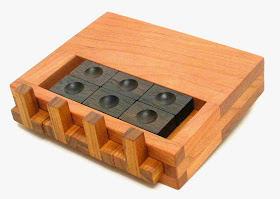 |
| Start Position |
Very nicely constructed of colourful laser cut acrylic, the Sorter is a "sealed" puzzle; meaning the sliding pieces are encased in the tray and you can't remove the pieces....not unless you unscrew the top cover...which is not intended.
 |
| Finished Position |
It took me a good several minutes to get the pieces into their intended positions and after the first time, I re-solved it and counted about 38 moves from start to finish. I am not sure if this is the optimal number of moves (probably not), so if anyone who has done it in lesser moves, please feel free to drop me a note.
Overall a nice sliding block puzzle with an appropriate level of difficulty, just right for an exchange puzzle.
Edit 28 Oct 14: A well-known puzzle collector and sliding block puzzle designer has messaged me to say that the Sorter needs only 22 moves to solve!....well there you go!










